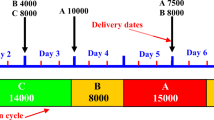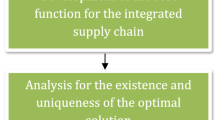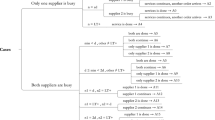Abstract
In this study, we address safety stock positioning when demand per period is a known constant but supply is uncertain. The supply is either available or not available, while the setting is that of a periodically reviewed, serial system following a base stock policy. Each stage is allowed to operate according to the guaranteed or stochastic service model. We use a Discrete Time Markov Chain model for expressing the expected on-hand inventories for each stage, along with other terms of interest, as a function of policy parameters determined by a given service level requirement for the end product. Exact models are constructed for single-stage and two-stage systems. As the number of states for a two-stage system grows exponentially, we propose an approximation for expressing the effect of the input stage using a single parameter. A generalization for the approximation is provided for a multi-stage problem. Computational evaluations of the approximation, as well as numerical comparisons of different cases, are presented.



Similar content being viewed by others
References
Atan Z, Ahmadi T, Stegehuis C, de Kok T, Adan I (2017) Assemble-to-order systems: a review. Eur J Oper Res 261(3):866–879
Axsäter S (2003) Supply chain operations: serial and distribution inventory systems. Handb Oper Res Manag Sci 11:525–559
Bollapragada R, Rao US, Zhang J (2004a) Managing inventory and supply performance in assembly systems with random supply capacity and demand. Manag Sci 50(12):1729–1743
Bollapragada R, Rao US, Zhang J (2004b) Managing two-stage serial inventory systems under demand and supply uncertainty and customer service level requirements. IIE Trans 36(1):73–85
de Kok TG, Visschers J (1999) Analysis of assembly systems with service level constraints. Int J Prod Econ 59(1–3):313–326
Diamantidis A, Papadopoulos C (2004) A dynamic programming algorithm for the buffer allocation problem in homogeneous asymptotically reliable serial production lines. Math Probl Eng 2004(3):209–223
Ehrhardt R, Taube L (1987) An inventory model with random replenishment quantities. Int J Prod Res 25(12):1795–1803
Ettl M, Feigin GE, Lin GY, Yao DD (2000) A supply network model with base-stock control and service requirements. Oper Res 48(2):216–232
Gavirneni S (2004) Supply chain management at a chip tester manufacturer. In: Harrison TP, Lee HL, Neale JJ (eds) The practice of supply chain management: where theory and application converge. Springer, Berlin, pp 277–291
Gershwin SB (1987) An efficient decomposition method for the approximate evaluation of tandem queues with finite storage space and blocking. Oper Res 35(2):291–305
Gershwin SB, Schor JE (2000) Efficient algorithms for buffer space allocation. Ann Oper Res 93(1–4):117–144
Graves SC, Willems SP (2003) Supply chain design: safety stock placement and supply chain configuration. Handb Oper Res Manag Sci 11:95–132
Graves SC, Willems SP (2005) Optimizing the supply chain configuration for new products. Manag Sci 51(8):1165–1180
Güllü R, Önol E, Erkip N (1997) Analysis of a deterministic demand production/inventory system under non-stationary supply uncertainty. IIE Trans 29(8):703–709
Güllü R, Önol E, Erkip N (1999) Analysis of an inventory system under supply uncertainty. Int J Prod Econ 59(1–3):377–385
Henig M, Gerchak Y (1990) The structure of periodic review policies in the presence of random yield. Oper Res 38(4):634–643
Hua NG, Willems SP (2016a) Analytical insights into two-stage serial line supply chain safety stock. Int J Prod Econ 181:107–112
Hua NG, Willems SP (2016b) Optimally configuring a two-stage serial line supply chain under the guaranteed service model. Int J Prod Econ 181:98–106
Inderfurth K, Minner S (1998) Safety stocks in multi-stage inventory systems under different service measures. Eur J Oper Res 106(1):57–73
Lee JH, Li J, Horst JA (2017) Serial production lines with waiting time limits: Bernoulli reliability model. IEEE Trans Eng Manag 65(2):316–329
Lee JH, Zhao C, Li J, Papadopoulos CT (2018) Analysis, design, and control of Bernoulli production lines with waiting time constraints. J Manuf Syst 46:208–220
Liberopoulos G (2018) Performance evaluation of a production line operated under an echelon buffer policy. IISE Trans 50(3):161–177
Naebulharam R, Zhang L (2014) Bernoulli serial lines with deteriorating product quality: performance evaluation and system-theoretic properties. Int J Prod Res 52(5):1479–1494
Parlar M, Berkin D (1991) Future supply uncertainty in EOQ models. Naval Res Logist (NRL) 38(1):107–121
Rambau J, Schade K (2014) The stochastic guaranteed service model with recourse for multi-echelon warehouse management. Math Methods Oper Res 79(3):293–326
Shih W (1980) Optimal inventory policies when stockouts result from defective products. Int J Prod Res 18(6):677–686
Silver E (1976) Establishing the order quantity when the amount received is uncertain. INFOR: Inf Syst Oper Res 14(1):32–39
Snyder LV, Atan Z, Peng P, Rong Y, Schmitt AJ, Sinsoysal B (2016) Or/ms models for supply chain disruptions: a review. IIE Trans 48(2):89–109
Song JS, Zipkin P (2003) Supply chain operations: assemble-to-order systems. Handb Oper Res Manag Sci 11:561–596
Weiss S, Schwarz JA, Stolletz R (2019) The buffer allocation problem in production lines: formulations, solution methods, and instances. IISE Trans 51(5):456–485
Wu K, Shen Y, Zhao N (2017) Analysis of tandem queues with finite buffer capacity. IISE Trans 49(11):1001–1013
Yano CA, Lee HL (1995) Lot sizing with random yields: a review. Oper Res 43(2):311–334
Author information
Authors and Affiliations
Corresponding author
Additional information
Publisher's Note
Springer Nature remains neutral with regard to jurisdictional claims in published maps and institutional affiliations.
Bengisu Urlu started conducting this research at Bilkent University. She continued working on it at Eindhoven University of Technology, and finalized at INSEAD.
Appendices
Appendix 1: Probability transition matrix for single-stage problem under the SSM

Appendix 2: Probability transition matrix for single-stage problem under the GSM

Appendix 3: Probability transition matrix for two-stage problem under the GSM

Appendix 4: Two-stage model: expressions for stage 1 for the SSM
SSM | |
|---|---|
Replenishment Time (\(\tau\)) | \(\tau =\begin{Bmatrix} i&with&probability&\pi ^{S_2}(1-p_1)(\sum _{j=0}^{i}[(1-\pi ^{S_2})^{i-j}p_{1}^{j}]) \end{Bmatrix}\) |
where i= 0,1,2,3,... | |
Demand during \(\tau\) | \(D=\begin{Bmatrix}iQ&with&probability&\pi ^{S_2}(1-p_1)(\sum _{j=0}^{i}[(1-\pi ^{S_2})^{i-j}p_{1}^{j}])\end{Bmatrix}\) |
where i= 0,1,2,3,... | |
\(E[D_\tau ]\) | \(Q\pi ^{S_2}(1-p_1)(\sum _{i=1}^{\infty }\sum _{j=0}^{i}[i(1-\pi ^{S_2})^{i-j}p_{1}^{j}])\) |
\(\sigma ^2_\tau\) | \(Q^{2}\pi ^{S_2}(1-p_1)(\sum _{i=1}^{\infty }\sum _{j=0}^{i}[i^{2}(1-\pi ^{S_2})^{i-j}p_{1}^{j}])\) |
\(-[Q\pi ^{S_2}(1-p_1)(\sum _{i=1}^{\infty }\sum _{j=0}^{i}[i(1-\pi ^{S_2})^{i-j}p_{1}^{j}])]^2\) |
Appendix 5: Two-stage model: probability transition matrix for stage 1 under the SSM

Appendix 6: Two-stage model: expressions for Stage 1 for the GSM
GSM | |
|---|---|
Replenishment Time | \(\tau =\begin{Bmatrix} i&with&probability&\pi ^{S_2}(1-p_1)(\sum _{j=0}^{i}[(1-\pi ^{S_2})^{i-j}p_{1}^{j}])\\ MQ&with&probability&1-\pi ^{S_2}(1-p_1)(\sum _{i=1}^{M_1-1}\sum _{j=0}^{i}[(1-\pi ^{S_2})^{i-j}p_{1}^{j}])\end{Bmatrix}\) |
where \(i=1,..,M_1-1\) | |
Demand during \(\tau\) | \(D=\begin{Bmatrix} iQ&with&probability&\pi ^{S_2}(1-p_1)(\sum _{j=0}^{i}[(1-\pi ^{S_2})^{i-j}p_{1}^{j}])\\ MQ&with&probability&1-\pi ^{S_2}(1-p_1)(\sum _{i=1}^{M_1-1}\sum _{j=0}^{i}[(1-\pi ^{S_2})^{i-j}p_{1}^{j}])\end{Bmatrix}\) |
where \(i=1,..,M_1-1\) | |
\(E[D_\tau ]\) | \(Q\pi ^{S_2}(1-p_1)(\sum _{i=1}^{M_1-1}\sum _{j=0}^{i}[i(1-\pi ^{S_2})^{i-j}p_{1}^{j}]) +\) |
\(MQ[1-\pi ^{S_2}(1-p_1)\sum _{i=1}^{M_1-1}\sum _{j=0}^{i}[(1-\pi ^{S_2})^{i-j}p_{1}^{j}]]\) | |
\(E[D_{\tau }^{2}]\) | \(Q^{2}\pi ^{S_2}(1-p_1)(\sum _{i=1}^{M_1-1}\sum _{j=0}^{i}[i^{2}(1-\pi ^{S_2})^{i-j}p_{1}^{j}]) +\) |
\(M^{2}Q^{2}[1-\pi ^{S_2}(1-p_1)\sum _{i=1}^{M_1-1}\sum _{j=0}^{i}[(1-\pi ^{S_2})^{i-j}p_{1}^{j}]]\) | |
\((E[D_\tau ])^2\) | \([Q\pi ^{S_2}(1-p_1)(\sum _{i=1}^{M_1-1}\sum _{j=0}^{i}[i(1-\pi ^{S_2})^{i-j}p_{1}^{j}]) +\) |
\(MQ(1-\pi ^{S_2}(1-p_1)\sum _{i=1}^{M_1-1}\sum _{j=0}^{i}((1-\pi ^{S_2})^{i-j}p_{1}^{j}))]^2\) | |
\(\sigma _{\tau }^{2}\) | \(E[D_{\tau }^2]-(E[D_\tau ])^2\) |
Appendix 7: Two-stage model: probability transition matrix for Stage 1 under the GSM

Appendix 8: Two-stage models: ranking according to expected total on-hand inventory costs
Rights and permissions
About this article
Cite this article
Urlu, B., Erkip, N.K. Safety stock placement for serial systems under supply process uncertainty. Flex Serv Manuf J 32, 395–424 (2020). https://doi.org/10.1007/s10696-019-09374-3
Published:
Issue Date:
DOI: https://doi.org/10.1007/s10696-019-09374-3




